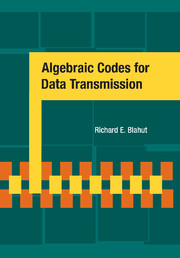Book contents
- Frontmatter
- Contents
- Preface
- Dedication
- 1 Introduction
- 2 Introduction to Algebra
- 3 Linear Block Codes
- 4 The Arithmetic of Galois Fields
- 5 Cyclic Codes
- 6 Codes Based on the Fourier Transform
- 7 Algorithms Based on the Fourier Transform
- 8 Implementation
- 9 Convolutional Codes
- 10 Beyond BCH Codes
- 11 Codes and Algorithms Based on Graphs
- 12 Performance of Error-Control Codes
- 13 Codes and Algorithms for Majority Decoding
- Bibliography
- Index
7 - Algorithms Based on the Fourier Transform
Published online by Cambridge University Press: 05 June 2012
- Frontmatter
- Contents
- Preface
- Dedication
- 1 Introduction
- 2 Introduction to Algebra
- 3 Linear Block Codes
- 4 The Arithmetic of Galois Fields
- 5 Cyclic Codes
- 6 Codes Based on the Fourier Transform
- 7 Algorithms Based on the Fourier Transform
- 8 Implementation
- 9 Convolutional Codes
- 10 Beyond BCH Codes
- 11 Codes and Algorithms Based on Graphs
- 12 Performance of Error-Control Codes
- 13 Codes and Algorithms for Majority Decoding
- Bibliography
- Index
Summary
An error-control code must be judged not only by its rate and minimum distance, but also by whether a decoder can be built for it economically. Usually, there are many ways to decode a given code. A designer can choose among several decoding algorithms and their variations, and must be familiar with all of them so that the best one for a particular application can be chosen. The choice will depend not only on the code parameters, such as blocklength and minimum distance, but also on how the implementation is to be divided between hardware and software, on the required decoding speed, and even on the economics of available circuit components.
In this chapter we shall broaden our collection of decoding techniques by working in the frequency domain. Included here are techniques for decoding in the presence of both erasures and errors, and techniques for decoding beyond the designed distance of a code.
Spectral estimation in a finite field
In Section 6.6. we studied the task of decoding BCH codes, including Reed–Solomon codes, up to the designed distance. This task will now be reinterpreted from the point of view of the Fourier transform. Using the terminology of the frequency domain, we shall develop alternative decoding procedures. These procedures will take the form of spectral estimation in a finite field.
- Type
- Chapter
- Information
- Algebraic Codes for Data Transmission , pp. 179 - 227Publisher: Cambridge University PressPrint publication year: 2003



